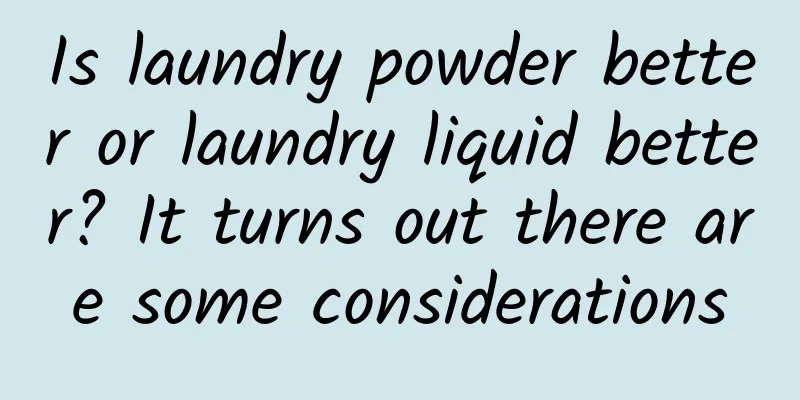Is laundry powder better or laundry liquid better? It turns out there are some considerations

|
When it comes to buying detergent, the choices are often bewildering. Which detergent should I choose to get a clean and economical wash? Bleach detergent, enzyme detergent, powder or liquid detergent? Understanding the chemistry involved can help answer these questions. What is Detergent The active ingredients in laundry detergents and liquids are a class of chemicals called surfactants . They are usually charged or ionic molecules with a hydrophilic and lipophilic structure that allows them to bind to grease or dirt and separate them from fabrics, suspending them in water. These substances then combine with air to form large amounts of foam on contact. Importantly, metal salts dissolved in water can limit the performance of surfactants. For example, hard water contains a lot of calcium and magnesium ions, which can easily react with surfactants to form soap scum. In response, current laundry detergents use phosphates, water softeners and other metal chelators to prevent the formation of soap scum. However, phosphates can cause algae blooms in freshwater, so their content is relatively low in current detergent formulas. Many products also contain fluorescent brighteners , chemicals that absorb UV rays to make clothes appear "whiter" or "brighter." Generally, fragrance is added to detergents, which is not necessary for cleaning, but it will give clothes a "fresh" feeling. In addition, some detergents also contain enzymes . Copyright images in the gallery. Reprinting and using them may lead to copyright disputes. What's in laundry detergent? The most critical ingredient in laundry detergent is the anti-scum ingredient, but the most common ingredient is salt , which is used to add volume and prevent clumping, such as sodium sulfate. Another commonly used salt is sodium carbonate, which reacts chemically with grease and dirt to make it soluble in water. In addition, washing powder often contains oxidants such as sodium percarbonate , which is a stable compound of sodium carbonate and hydrogen peroxide. When dissolved in water, it will decompose into oxygen, water, and sodium carbonate, which has the effect of oxidative bleaching. This is also the reason why washing liquid with water as the main ingredient does not add sodium percarbonate. In addition, washing powder generally adds a bleach activator, tetraacetylethylenediamine, to activate sodium percarbonate and produce a mild bleaching effect at room temperature. Sodium percarbonate is also the main ingredient of explosive salt and washing machine tank cleaning agent , which can remove stubborn stains such as fruit stains, blood stains, oil stains, etc., and has a certain bactericidal effect. Copyright images in the gallery. Reprinting and using them may lead to copyright disputes. From a chemical point of view, the advantage of laundry detergent is that the ingredients can be mixed as needed and remain in solid form. You can see different particles in the laundry detergent. In addition, the fragrance in the laundry detergent is not a necessary ingredient, but it does leave a clean feeling. What's in laundry detergent? Laundry detergent mainly contains water, but also includes alkali salts, metal chelating agents, water softeners and surfactants. They must form a stable system in the bottle and work synergistically during the washing process. The surfactants in laundry detergents are usually classified as ionic or non-ionic, depending on whether they are charged or not. Non-ionic surfactants are generally liquid, so they are not suitable for use in laundry powders. They can suspend oil in water and prevent soap scum from forming. Generally speaking, laundry detergent also contains preservatives to prevent the growth of microorganisms. However, laundry detergent generally only contains fluorescent whitening agents, unlike washing powder, which also contains peroxide bleach that can kill bacteria . Therefore, if you mainly use laundry detergent for washing, mold is more likely to grow in the washing machine, and bacteria on clothes are more likely to be transmitted to each other. Copyright images in the gallery. Reprinting and using them may lead to copyright disputes. In recent years, businesses have also packaged high-concentration laundry detergent in capsules to make laundry beads that are easy to add . However, when using laundry beads, it is difficult for users to flexibly adjust the dosage. In addition, enzymes in detergents are natural proteins that catalyze and accelerate chemical reactions to remove certain stains. As the names suggest, lipase breaks down fats, proteases break down proteins, and amylases and mannanases break down starch and sugars, respectively. However, high temperatures can destroy the structure of enzymes and render them ineffective, so it is generally recommended to use enzyme-containing detergents in warm water at 15-20 degrees Celsius . As for whether to choose laundry detergent or powder, if you know a little more about chemistry, you may be able to choose the right detergent according to your needs. References [1]https://theconversation.com/whats-the-difference-between-liquid-and-powder-laundry-detergent-its-not-just-the-obvious-239850 Planning and production Source: Global Science (ID: huanqiuekexue) By Nathan Kilah Translated by Ma Yiyuan Editor: He Tong Proofread by Xu Lai and Lin Lin The cover image and the images in this article are from the copyright library Reprinting may lead to copyright disputes |
<<: AI plays games better than humans? But what's the point of letting AI play games...
>>: Children's tic disorder: beware of the health risks hidden in "small movements"
Recommend
Was it North Korea that attacked Sony? Hackers spoof: FBI is an idiot
The hacker group "Guardians of Peace" t...
Oculus founder: Virtual reality is still 10 years away from you
In a recent interview with the Financial Times, O...
Hot topic! Is the crunchy Gongcai in hot pot actually dried lettuce?
Recently, the topic #Gongcai is dried lettuce# ha...
Private cars are cleaned up and turned into express cars: paving the way for Didi Kuaidi's listing
On May 7, Didi launched the Didi Express project ...
Once in 50,000 years! A rare green comet will "approach" the Earth on February 2. How to observe it?
The green comet, which occurs once every 50,000 y...
International first! Chinese scientists have made a major breakthrough
Quantum simulation experiments have made a major ...
Practical review: How to increase the number of paying users from 0 to 700 in 3 months?
I have seen many products that were poorly made. ...
Have you ever paid the IQ tax of the "quantum teacup"? Quantum computing: the solution to improve computing power in the post-Moore era
"Quantum" is already a hot research fie...
SEMI: Global semiconductor equipment sales are expected to reach US$139 billion in 2026, with China ranking first
Recently, the Semiconductor Industry Association (...
When will the iPhone's battery life be as good as the iPad's?
What do you want from the new generation of iPhon...
What will happen to your body if you eat one sausage a day? Is it okay to eat a sausage that costs 2 yuan?
"Give me a sausage, thank you!" Image s...
Xinxiang Mini Program Development Company, how much does it cost to make a film and television mini program?
Xinxiang Mini Program Development Company, how mu...
How can you get users to share and help you acquire customers without spending a penny?
Through user sharing and word-of-mouth recommenda...
"Happy family" or "Happy family", is it really true that you can't make the mistake in using them when greeting the new year?
Author: Cleaner, PhD student in Exegesis at Nanka...









